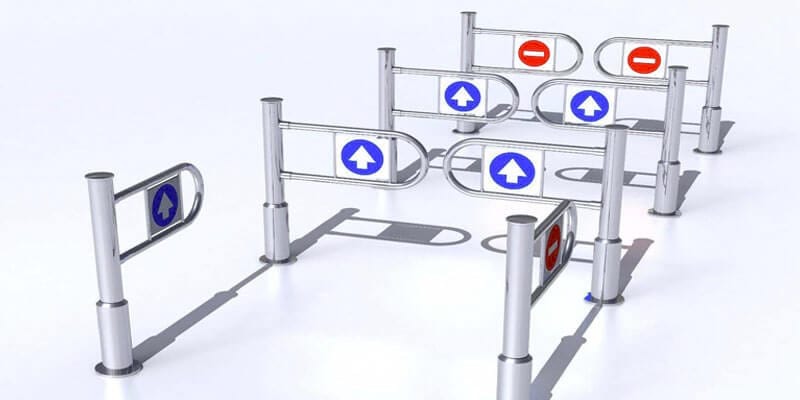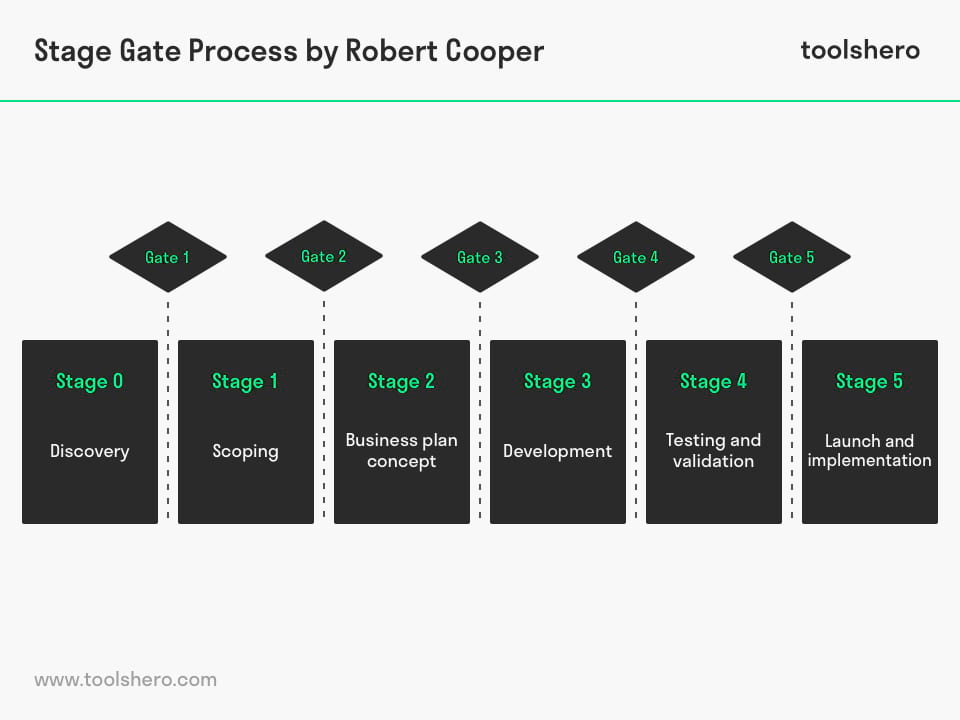Which of the Following Is Not Part of the Improve Gate Review Criteria?
Stage Gate Process (Cooper)

Stage Gate Procedure: this commodity explains the concept of the Stage Gate process, adult past Robert Cooper in a practical fashion. Afterward reading it, you will understand the basics of this powerful innovation and project direction concept.
What is the Stage Gate process?
The State Gate procedure is a patented trademark of Robert Cooper. The model focuses on the innovation process and is also referred to as the waterfall procedure.
It is a project direction technique, in which an initiative or project takes place, divided over several stages. These stages are separated by so-chosen 'gates'; the decision points for whether or not to proceed to the next stage.
Do you want unlimited and advertizement-free access?
The phase gate model can exist used when developing new products, process changes, quality control or improvements.
The Stage Gate Process explained
At each gate, a determination is made whether to continue the process or not. This conclusion is based on the prognosis and information available at that moment and in most cases is made by a director or steering committee. The quality of an thought is assessed at each of the gates.
This concerns the quality of the execution past a cross functional team or project teams, business concern motivation to keep financially and the action programme showing what needs to be done in order for the project to accept a chance at succeeding.
Later each gate, one of the following decisions can be fabricated:
Go
The projection is practiced enough to move on to the next stage.
Impale
The project is not good enough to develop further and is shut down correct away.
Concord
The project is not good enough to go on to develop it at this moment, but non so bad that it needs to be shut down immediately. It is put on hold to peradventure be resumed at a afterward date.
Recycle
The project is good enough to develop further, provided some changes are fabricated.
Phase Gate model
The process consists of a number of stages, which are continued to each other past gates in the Stage Gate model. Each stage is designed to collect specific information:
- Stage 0: discovery
- Stage one: scoping
- Stage ii: business plan concept
- Stage 3: evolution
- Stage iv: testing and validation
- Phase 5: launch and implementation
Depending on the size of the projection, ii, 3 or all 5 stages are completed. A project that focuses on major product innovation volition go through all five stages. A projection with less risk will suffice with just phase 1 (scoping) and stage two (development of the business plan) and developing it to stage 4 (testing and validation). W
ith very small or uncomplicated adjustments, only stage iii (evolution) and phase 4 (testing and validation) volition exist implemented. Examples are marketing requests or an application to modify an existing production.

Stage 0: discovery
This initial preparatory stage determines which project a company wants and is able to bear out. Ideas tin can be generated in brainstorming sessions.
Employees are non the but ones involved in this office. Customers and suppliers also provide useful information. An idea is first selected and and then proposed. If the idea is not worth the effort, the gate closes here.
Stage 1: scoping
It is all about portfolio management: evaluating the products and the associated markets. What are the product's strengths and weaknesses and what can it bring to the user/consumer in terms of added value?
This stage takes all the possible threats from competitors into account. Based on the assessed threat, production will or volition non keep. The greater the threat, the greater the adventure that the gate will close.
Stage 2: business concern program concept
Now that the product is impervious to competition, a business organisation plan is drawn up.
This is the last stage of concept development and is crucial before the starting with evolution of the bodily product. This stage is very labour-intensive and includes sub-stages that need to be completed:
Production definition and analysis
The customer value is determined past finding out which benefits the product offers and what conditions and functions it must meet. This information tin be retrieved with the aid of interviews and surveys. We also look at the environment and the contest.
Creating the concern plan
In this document the product is described and defined, including the legal health and safety requirements.
Creating the projection programme
This plan contains a list of all tasks that are planned during the unabridged evolution procedure, and the people who will carry them out. The expected launch engagement tin can also be found in this plan.
Feasibility review
This last step is the most important one of the phase. It'south the business example.
The business organisation example includes a feasibility study in which different departments assess the program's chances of succeeding. If, after this stage, the business organization case appears that the business concept does not have sufficient potential to generate turnover, the gate will close.
Stage three: evolution
During the product development procedure stage, the plans from the previous steps are carried out and elementary tests are conducted. For case, at this stage customers can exist asked what they think of the product.
The development team likewise creates a timeline with specific milestones that have to exist accomplished. This timeline can be revised and updated regularly.
It as well incorporates multi-functional teamwork; different departments provide input with expert advice. The cross functional squad ultimately results in a production prototype, which volition be extensively tested during the next stage. The gate will remain closed if the production has not been sufficiently developed.
Phase 4: testing and validation
This covers product testing and validation. They besides look at the manufacturing process and how the production is accepted by customers and the market. This also means that a number of sub-stages are completed during this stage:
Near testing
The purpose of this exam is to identify possible product errors or other bug. It is no longer a paradigm; the production is almost set up to be sold.
The groups that deport out this test are closely tied to the organization. They include staff, regular customers and suppliers.
Field testing
In this office, the product is tested in the field by various participants who can make a valuable contribution. This is commonly done with the assistance of customers.
It is important to notice out whether this target group is interested in the production, which characteristics they consider important and in which context the production volition be used.
Market testing
This test is optional If the product is offered in the market place, information technology has already passed through the previous test stages. This means that sometimes, after a period, the production is assessed to run into whether information technology sufficiently matches the needs and wishes of the consumer.
The production is usually pretty much in its final form after testing. Notwithstanding, there also has to be a good marketing program to launch the production. If not, the gate to the next phase will remain closed.
Stage 5: launch and implementation
The marketing strategy comes into play during the launch process in the process. The product is ready to be launched, which will include a off-white corporeality of hype, by means of for instance an advert campaign, free publicity (press releases) and interviews.
An gauge is made virtually the quantity that will be sold. Policies regarding product, inventory and distribution must be set. The sales team is predominantly responsible for ensuring a polish process.
Stage Gate Process and constructive gates
The transitions betwixt the different stages are in the Stage Gate Process monitored by the gates mentioned before. These gates take the added role of putting a finish to the evolution of weak projects in order to preclude unnecessary work.
After all, that can toll a lot of fourth dimension and coin. In that sense, the gates are the points that provide an overview of the project so far. This is the crucial moment to brand get / kill / concord / recycle decisions and prepare priorities. It is important that these ports have clear and visible criteria beforehand.
In most cases this is done based on components that the project must encounter at that specific level in development. If the project fails to meet the criteria, the determination is made to terminate developing farther.
Advantages of the Stage Gate procedure
The Stage Gate process has a number of advantages. The most important can be found below:
- Reducing production errors
- Reducing errors and waste product of raw materials
- Internal focus on the correct projects
- Skilful communication between different departments
- Clarity most all planned projects
- Practiced communication betwixt external stakeholders, including customers, partners and suppliers
Get Toolshero updates on new methods, models and theories!
It's Your Plough
What do you think? What are your experiences with the Stage Gate process? Do you recognize the practical caption or do you accept more than suggestions? How do you lot decide whether to continue with a procedure or not?
Share your experience and knowledge in the comments box below.
More than data
- Cooper, R. Yard., Edgett, S. J., & Kleinschmidt, East. J. (2002). Optimizing the phase-gate process: what best-practice companies are doing. Research-Technology Management, 45(5), 21-27.
- Cooper, R. G. (1990). Stage-gate systems: a new tool for managing new products. Business horizons, 33(iii), 44-54.
- Website Stage-Gate International: https://www.stage-gate.com/
How to cite this commodity:
Mulder, P. (2018). Phase Gate Process (Cooper). Retrieved [insert date] from Toolshero: https://www.toolshero.com/innovation/phase-gate-process/
Add a link to this page on your website:
<a href="https://www.toolshero.com/innovation/stage-gate-process/">Toolshero: Stage Gate Process (Cooper)</a>
Published on: 09/09/2018 | Final update: 12/06/2021
RECEIVE NEW ARTICLES + FREE GIFT
Join 16.000+ members who become oftentimes toolshero customs updates! Including a costless souvenir, the Business Model You template
No, close this popular-up
RECEIVE NEW Manufactures + Complimentary TOOLSHERO TEMPLATE
Bring together 17.000+ members who get often toolshero customs updates! Receive, next to new articles, the practical "Business Model You" template costless of charge, to help you with your adjacent professional person and personal steps!
No, close this pop-upward
Source: https://www.toolshero.com/innovation/stage-gate-process/
0 Response to "Which of the Following Is Not Part of the Improve Gate Review Criteria?"
Postar um comentário